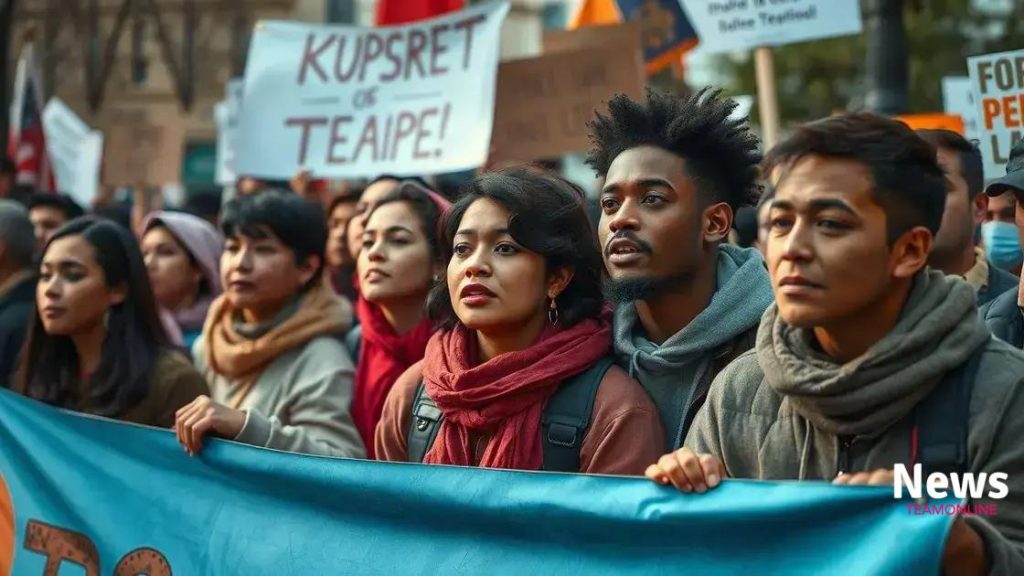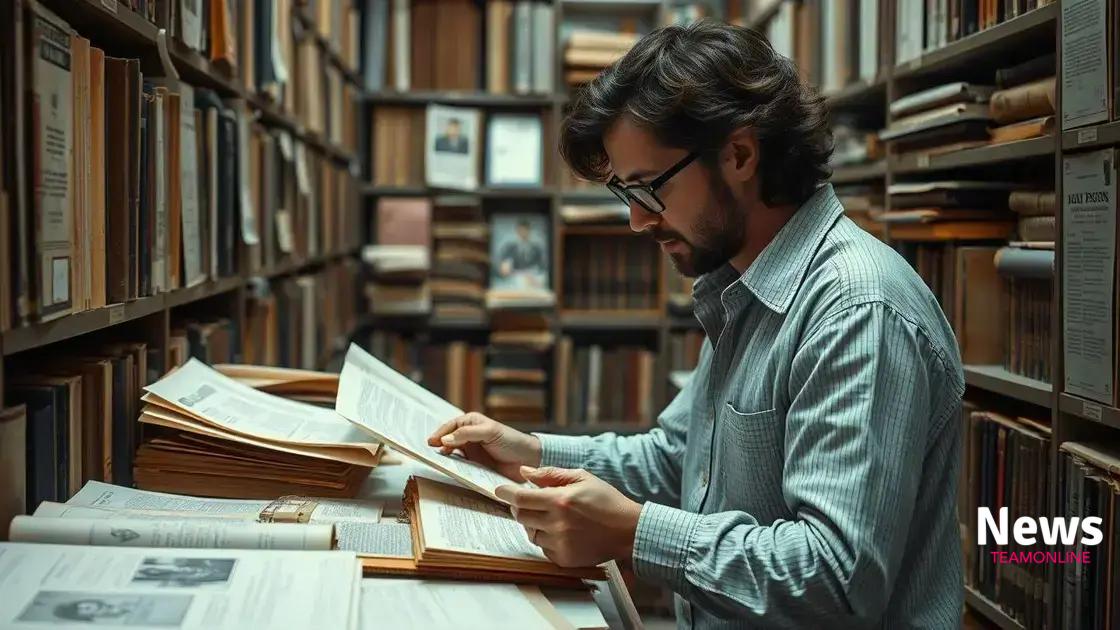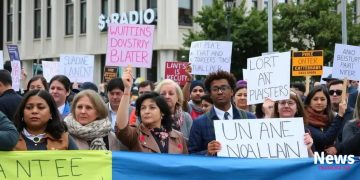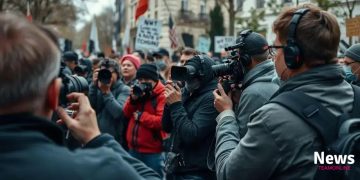Protest timeline documentary projects: a journey through events

Impactful protest documentaries use strong visuals, thorough research, and engaging narratives to highlight social issues and empower marginalized voices, driving awareness and inspiring action.
Protest timeline documentary projects delve into the stories behind significant events, connecting past struggles to present discussions. Have you ever wondered how these narratives shape our understanding of history?
Understanding the significance of protest timelines
Understanding the significance of protest timelines is crucial for creating impactful documentary projects. These timelines serve as visual representations of events, allowing viewers to grasp the flow of history and the evolution of social movements. By placing individual protests within a broader context, we can see how they connect to larger societal changes.
Why Protest Timelines Matter
In documentary filmmaking, using a timeline can enhance the narrative structure. It helps to illustrate how protests are not isolated incidents but part of a series of events that reflect public sentiment over time. Here are some key reasons:
- They provide a historical context for each protest.
- They highlight the causes and consequences of social movements.
- They allow viewers to see patterns in activism.
- They engage audiences with a visual storytelling format.
Furthermore, when creating a protest timeline, it’s essential to consider the events leading up to and following each protest. This captures the *nuances* of social change. Examining these connections shows the impact of grassroots organizing and how individual voices contribute to collective action.
Crafting an Effective Timeline
When you craft a timeline, clarity and accuracy are paramount. A well-organized timeline offers easy navigation and understanding for your audience. Here’s how to create an effective timeline:
- Identify key events and milestones.
- Chronologically arrange these events.
- Incorporate visuals such as photographs or icons.
- Use concise descriptions to explain each event’s significance.
The significance of these timelines extends beyond just chronicling events. They also facilitate discussions about the evolving landscape of protest movements. By analyzing timelines, we can uncover stories that may have been overlooked, giving voice to marginalized perspectives.
In conclusion, protest timelines are powerful tools in documentary projects. They not only educate viewers but also inspire engagement with the issues at hand. Understanding how to effectively present these timelines can make a significant difference in how audiences interpret social movements.
Key elements of effective documentary projects
When creating a documentary, understanding the key elements is essential for success. Each element contributes to storytelling, making the viewer feel connected to the subject matter. By focusing on these components, filmmakers can craft a powerful narrative that resonates.
Research and Pre-production
Solid research forms the foundation of any documentary project. This stage helps identify what stories need to be told and the best way to present them. Comprehensive research allows filmmakers to gather facts, interview subjects, and understand their topics deeply. Preparing thoroughly before filming is crucial for ensuring the documentary’s credibility.
- Identify core themes and messages.
- Conduct interviews with experts and stakeholders.
- Collect relevant data and statistics.
- Create a detailed production plan.
Once research is done, planning the documentary’s structure becomes the next step. Clear organization helps streamline the storytelling process.
Engaging Visuals
Effective documentaries rely heavily on engaging visuals to convey their message. Strong imagery can evoke emotions and highlight key points, leaving a lasting impression on the audience. Consideration of camera angles, lighting, and shot composition plays a critical role in achieving this goal. For instance, close-up shots can reveal emotions, while wide shots set the scene.
Incorporating various visual elements, such as archival footage or graphics, enriches the viewing experience. This approach also enables viewers to better understand complex information.
Compelling Narration
A captivating narration weaves the entire documentary together. The choice of voice and tone impacts how messages are perceived. A resonant voice adds authority, while a conversational style can make the information feel approachable. Keeping the narration clear and concise allows audiences to follow along easily.
- Choose a narrator that fits the documentary’s theme.
- Utilize emotional and engaging language.
- Maintain a consistent tone throughout the project.
- Balance facts with storytelling.
Throughout the documentary, the emotional connection established between the audience and the subject can create a more impactful experience. Filmmakers should aim to tell human stories that reflect real-life struggles, victories, and challenges.
Ultimately, focusing on these key elements enhances the effectiveness of documentary projects. By combining thorough research, engaging visuals, and compelling narration, filmmakers can create documentaries that resonate with audiences and spark meaningful conversations.
How to research and curate protest stories

Researching and curating protest stories is a vital part of creating meaningful documentary projects. Effective research not only provides context but also brings authenticity to the narrative. It allows filmmakers to uncover the history behind protests and identify compelling stories that need to be told.
Identifying Sources
The first step in research is identifying a variety of sources. This could include books, articles, and documentaries about specific protests. Additionally, firsthand accounts, such as interviews with activists, are invaluable. By gathering stories from multiple perspectives, filmmakers can create a more rounded view of the events.
- Utilize libraries and archives for historical documents.
- Explore online databases and news articles.
- Conduct interviews with participants and witnesses.
- Engage with online forums and discussion groups.
Once sources are identified, the next step is organizing the information. Creating an outline or timeline can help filmmakers visualize how the stories fit together and address the overall theme.
Curating the Narrative
After gathering information, it’s essential to curate the narrative thoughtfully. This involves selecting stories that align with the documentary’s message and resonate with audiences. Prioritizing the most compelling narratives allows filmmakers to focus on elements that will engage viewers.
Consider the emotional impact of each story. Choosing narratives that represent diverse voices gives depth and richness to the project. Some important factors to consider when curating include:
- Relevance to current social issues.
- Diversity of perspectives and experiences.
- Historical importance and context.
- Unique or powerful personal stories.
In leaning towards a cohesive narrative, filmmakers should aim for a balance between factual information and human stories. Combining these elements creates a more engaging and relatable documentary.
Additionally, it is critical to fact-check each story before including it in the documentary. Ensuring accuracy not only builds trust with the audience but also strengthens the documentary’s overall impact.
By focusing on rigorous research and thoughtful curation, documentary filmmakers can tell powerful, authentic stories that honor the struggles and victories of those involved in protests. The ability to connect past and present experiences through stories will make the documentary resonate even more with viewers.
Techniques for creating engaging visual narratives
Creating engaging visual narratives is essential for effective documentary projects. Visual storytelling captivates audiences and makes complex topics accessible. To achieve this, filmmakers can use various techniques that enhance the viewing experience and convey emotions effectively.
Utilizing Strong Imagery
One technique is the use of strong, high-quality imagery. Powerful visuals can evoke emotions and drive the narrative forward. Filmmakers should select images that resonate with the theme of the documentary. These images should illustrate key moments and highlight the emotional stakes of the story.
- Choose images that reflect the tone and mood of the content.
- Incorporate a mix of wide shots for context and close-ups for impact.
- Use color grading to enhance the emotional tone of visuals.
- Consider including archival footage to provide historical context.
In addition to effective visuals, transitions between scenes play a significant role in maintaining viewer engagement. Smooth transitions keep the narrative flow intact, allowing audiences to follow the story seamlessly.
Incorporating B-Roll Footage
B-roll footage enhances documentaries by providing additional context and depth. This additional content can reveal emotions, environments, and reactions that might not be captured in primary interviews. When strategizing the use of B-roll, filmmakers should aim for variety.
Consider including the following types of B-roll:
- Lifestyle shots of people engaging in activities related to the protest.
- Landscapes or cityscapes that provide context to the events.
- Behind-the-scenes moments showing preparation for the protest.
- Reactions of onlookers and participants during key moments.
Each of these elements adds richness to the documentary, allowing viewers to feel more connected to the subject matter.
Storyboarding and Planning
Another technique is storyboarding, which involves planning the visual sequences before filming. This helps filmmakers envision the flow of the narrative and decide on key shots ahead of time. A well-structured storyboard ensures that the documentary stays focused and organized.
The process of planning visuals allows filmmakers to:
- Identify pivotal moments that need to be highlighted.
- Determine the emotional arc of the story.
- Plan for necessary interviews that enhance the narrative.
- Ensure a variety of shot types to keep visual interest.
Additionally, incorporating graphic elements can aid the narrative. Infographics, captions, and subtitles can provide clarity and highlight important information. These elements make complex data digestible and keep the audience engaged.
By employing these techniques, filmmakers can create visual narratives that are not only engaging but also evoke emotional responses from audiences. Ensuring that every visual element serves the story leads to a more impactful documentary.
Case studies of impactful protest documentaries
Case studies of impactful protest documentaries provide valuable insights into how storytelling can shape public perception and drive social change. These films often highlight the struggles of marginalized groups, making their voices heard and emphasizing the importance of historical context.
Documentary Examples
One significant example is “13th,” directed by Ava DuVernay. This documentary examines the history of racial inequality in the United States and the intersection of race, justice, and mass incarceration. It effectively combines archival footage, expert interviews, and data visualization to convey its powerful message.
- Highlights systemic racism in the criminal justice system.
- Utilizes statistics and expert opinions for credibility.
- Evokes emotional responses through personal stories.
- Encourages viewers to engage in activism.
Another noteworthy documentary is “The Act of Killing,” directed by Joshua Oppenheimer. This film explores the Indonesian mass killings of 1965-66 from the perspective of the perpetrators. By allowing them to reenact their actions, the film reveals the psychological scars and the culture of impunity surrounding these events.
Learning from Success
Analyzing these impactful documentaries shows how effective use of storytelling techniques can elevate a message. Focusing on personal narratives draws viewers into the emotional core of the subject matter. It allows audiences to understand the human aspects behind protests.
Moreover, these documentaries emphasize the importance of research in portraying accurate representations of events. They often feature:
- Thorough historical analysis.
- Expert interviews providing context.
- Firsthand accounts from those affected.
- Visuals that evoke strong emotional reactions.
Such films serve not only to inform but also to inspire. They show how visual narratives can mobilize support for social causes and push for necessary changes in society. Furthermore, these documentaries invite the audience to be part of the conversation about justice and human rights.
By studying these impactful documentaries, aspiring filmmakers can learn the foundations of effective protest storytelling. The techniques and insights from successful projects serve as a guide to understanding the power of visual storytelling in advocating for change.
FAQ – Frequently Asked Questions about Impactful Protest Documentaries
What makes a protest documentary impactful?
An impactful protest documentary effectively tells a compelling story, uses strong visuals, and highlights marginalized voices, driving viewers to understand and engage with social issues.
How important is research in documentary filmmaking?
Research is crucial as it ensures accuracy, provides context, and helps filmmakers understand the stories they want to tell, making their narratives more authentic and informed.
What techniques can enhance visual storytelling in documentaries?
Techniques such as using strong imagery, incorporating B-roll footage, and smooth transitions can significantly enhance visual storytelling, making the documentary more engaging.
How can filmmakers learn from existing protest documentaries?
Filmmakers can study successful protest documentaries to understand effective storytelling methods, visual techniques, and ways to engage audiences in social issues.





